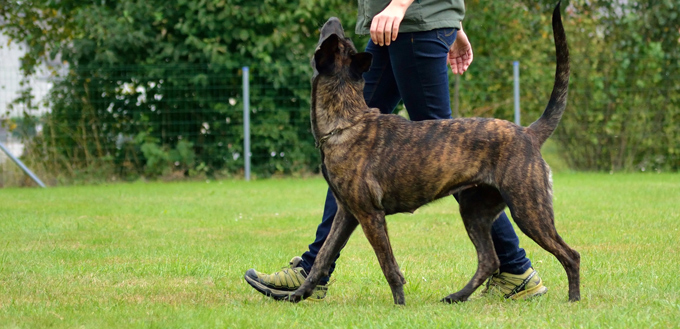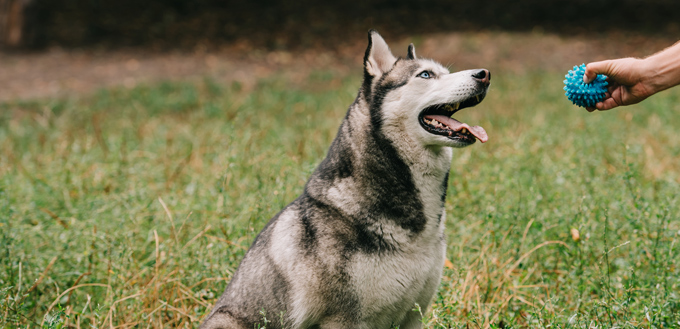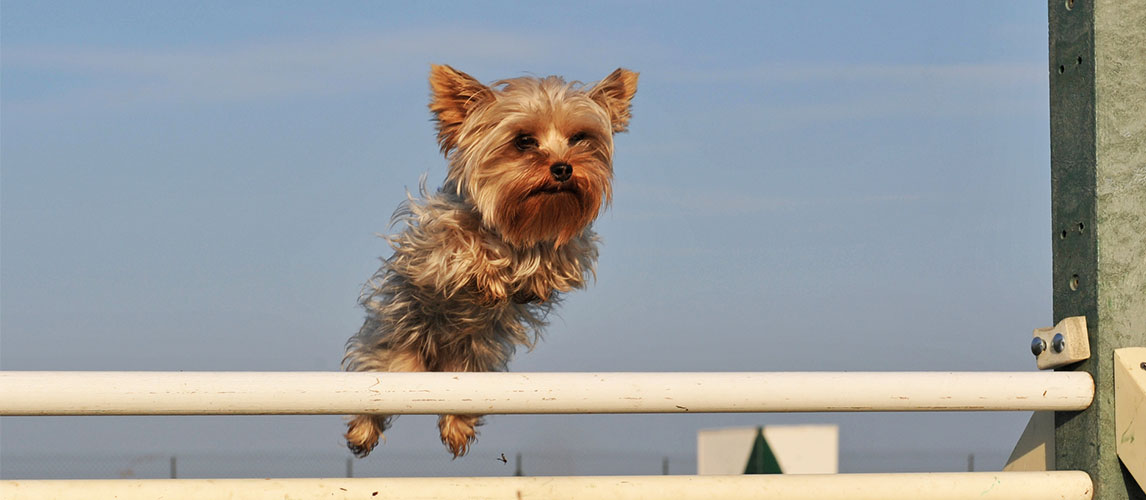It’s a big decision to call in a dog trainer for your beloved pooch. It’s an even bigger decision to choose the right one. New dog owners, and even those who are experienced in the canine world, can struggle to know what to do for the best. There can be confusing terminology and extravagant claims made about different methods. Here we try to unpick some of the mystery and give you some straightforward advice on choosing a dog trainer for the most important furry friend in your life.

What is a Dog Trainer?
Dog trainers work with owners to establish positive patterns of behaviour in their dog. They may be called in when the dog is a puppy or when things have started to go wrong. A dog learns from interactions it has with its environment and dog trainers use this to promote good behaviour. The aim is for the owner, and not the dog, to be in control. Often, the owner needs as much training as the dog does.
What to Look for When Choosing a Dog Trainer?
It’s important that you know how to spot a dog trainer that will work well with you and your dog. In the end, this may come down to a gut feeling but there are certain characteristics that you should look out for. Here are the main ones.
- They are good at listening: Communication is a vital skill and dog trainers need it just as much as other trades and professions. However, communication is not just about talking, it is about listening as well. You should be able to tell from the initial phone calls and emails whether the trainer is willing to listen to you. If they are only interested in telling you what to do and don’t listen to you, it would be best to give them a miss.
- They are easy to understand: Communication is also about making sure that the other person has taken on board and understood what you are saying. This is all about having good people skills. A good trainer will not use complicated terminology and will stop and allow you to ask as many questions as you like. They should be willing to go at your pace.
- They use positive methods of control: One of the most challenging aspects of dog training is the control of negative behaviours. This is usually much harder than teaching a dog some simple commands such as ‘sit’ or ‘stay’. A skilled and experienced dog trainer will know how to use positive reinforcement to tackle troublesome behaviours such as separation anxiety and aggression. Always avoid hybrid trainers (they use positive techniques and punishment). A good dog trainer does not have to resort to punishment.
- They take time to know your dog: When you take your dog to the vet, they start by taking a full medical history and asking a lot of questions about the background to the illness. A good dog trainer should do the same. They should want to know all about your dog’s background and when/where/how any negative behaviour started. This will enable them to quickly identify what has caused the problem and how to stop it.
- They work with all the family: If your dog’s new training regime is going to work, the whole family has to be on board. This is because consistency and continual reinforcement are vital. They will probably ask that all of the household are available for at least some of the training sessions. The focus should always be on you as much as the dog. They are effectively giving you the skills to handle your dog yourself when they are not around.
- They will have references: A personal recommendation from a friend or family member is preferable but if that is not possible, a good trainer will have plenty of satisfied clients who will be happy to talk to you. Talk to these clients in private and not in front of the trainer so that they can be completely honest. If possible, meet up with them in a public place with their dogs and see the results for yourself.
- They will have appropriate insurance: Legitimate dog trainers are business owners and need a certain amount of paperwork in place. Public liability insurance provides insurance cover for them should anyone or anything become damaged as a result of their work. All legitimate tradespeople and professionals have it. It provides you with protection should something go wrong during the training.

7 Things You Should Know When Choosing a Dog Trainer
There is a lot of confusion and misinformation about dog trainers. Here’s a no-nonsense guide to the seven things you should know before you choose one yourself.
Dog Trainers Don’t Have to be Registered or Licensed
Anyone can set themselves up as a dog trainer. It really is as simple as starting up a social media account or a simple website. There are no exams to pass and they do not have to be a member of a professional body (although some do exist). Therefore, it is impossible to get ‘struck off’ as vets, doctors and other professionals can be. Opinions on the best ways to train dogs differ widely! Methods than one person claim are the best can be completely discredited by another. There are lots of fads that come into fashion and then become very unpopular. The only way you can be sure that a dog trainer’s methods are effective is to see them in action and witness the results for yourself.
There is no Agreed Definition of Training
One person may regard a dog as ‘trained’ but another would not. There are no specified criteria that a trained dog should meet such as ‘sitting’, ‘staying’ or ‘fetching’ to command. There may be specific sets of skills that a dog can achieve or not but that does not mean the same thing as ‘trained’. Some dog trainers simply try to improve the relationship between owner and dog whereas others are a lot more technical. This makes it almost impossible for dog owners to compare training programmes to work out what would be best for them. Obedience commands underpin some training regimes because the trainers think that this will solve all behaviour problems. On the other hand, other trainers avoid obedience commands because they think that they play no role in controlling troublesome behaviour. Yet more trainers are in the middle of these two extremes. They believe that there is a role for traditional obedience training but that there may be other solutions that are more reliable and work faster. It is important that you talk to the trainer before you hire them, establish exactly what they are trying to achieve with your pooch and precisely how they will go about it.
There is no Single Way of Changing Behavior
There as many different approaches to changing behaviour as there are trainers. Each method has its own terminology so you may read things like ‘force-free approach’, ‘balanced approach’ and ‘positive approach’ but you won’t know exactly what they mean. Sadly, there is no clear definition of what each of them means. Some dog trainers say that they use ‘force-free’ methods but are not clear what they mean by force. Do they mean verbal as well as physical punishments and would yanking on a collar be included in that definition? Whilst these terms will give you a general idea about what the approach of an individual trainer is, it does not fill in the detail. Sadly, these descriptions do not indicate whether the trainer is actually skilled in that approach. Results are what matters here rather than fancy descriptions and labels.
Being Stuck to one Method is Not Helpful
If a trainer continually focuses on just one method of training, it should make you wary. It indicates a certain lack of flexibility and can mean that they are focussing on the method to avoid talking about results! A trainer who harshly criticises other trainers and insists that they are the only one with all the answers should also ring alarm bells. What are they so worried about? Why can’t they rely on their own satisfied customers to do the selling for them.? A bit of healthy competition is fine but it can look very unprofessional to harshly criticise other service providers. There are actually many ways to teach a dog to sit and as long as they work for that particular dog, they are fine. The best approach is to find a trainer who is always open to discussing and hearing about new methods and who accepts that there are many approaches. A good trainer will be happy to hear about and discover new ways of working with their clients.
Some Methods are Best Avoided
Obviously, any method that physically or emotionally damages your dog is to be avoided completely. You must be able to trust the trainer completely with your much-loved four-legged friend. However, even some ‘safe’ training methods can cause your pooch to become confused, resistant or resentful. You could end up spending a lot of money just to make your dog miserable. You are looking for some evidence of flexibility. If one method doesn’t work, are they prepared to try something else? Will they adapt their training methods to suit your pooch? This is the fastest and kindest approach to dog training. It takes skill to adapt a training method to suit the individual dog that you are working with.
Trainers Need to Work With You Too
The trainer-owner relationship is just as important as the trainer-dog relationship. Training the owner is often harder than training the dog! You have to realise that, as the owner, you need to learn new skills too. This means that you have to be able to get on with the trainer. If you have a clash of personalities, it is not going to work. You need to make changes to make sure that the training is not undermined and that the old bad behaviour does not come back. The training process should equip you with skills to promote continuing good behaviour. You cannot slip back into your old ways or the training will be undone and the behaviour problems will come back! The trainer that you choose should show that they want to work closely with you and teach you how to manage when they are not around!
Animal Abuse Can Happen
There are different definitions of abuse but you will know it when you see it. Some trainers will label other trainers as abusive simply because they say ‘no’ to a dog but this is more about professional rivalry than abuse. It is extremely rare for dog trainers to use any kind of force to train a dog and abusive dog trainers are very rare. However, that does not mean that they do not exist. It is up to you to protect your pooch by arriving at your own definition of what you think is abuse and then refusing to accept it. To build up your trust in your chosen trainer, you could ask for a few private lessons where you can sit in and see what’s happening. Trust your instincts and pick up on the subtle signals that your pooch is sending you. If they are delighted with their dog trainer and are happy and relaxed in their company then you can stop worrying. You are the best judge of your dog’s happiness.

You need to take your time to find the right trainer for your pooch. Talk to friends and family and look out for personal recommendations. Remember that results are what matters and trust your instincts. If your dog is happy, then you will be too!
Sources:
- Cesar Millan, 5 Rules for Choosing a Dog Trainer, HuffPost
- Marc Bekoff Ph.D., Choose a Dog Trainer as Carefully as You Would a Surgeon, Psychology Today







